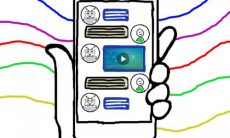Have you ever tried explaining astronomy and global weather patterns to an eight-year-old boy? It’s painful just to think about trying to get him to sit still for 5 minutes. This may explain why cultures create myths to explain their worlds. For example, many Native American tribes created myths explaining the weather and seasons. These myths surround the dry (but vital) facts with compelling and memorable details and create a much more emotional connection with the information. The stories are how this important information gets passed down from generation to generation.
Your own experiences in school probably back this up. What was more interesting, the laundry list of facts and figures about the waves of immigrants to the United States – how many came through Ellis Island, what years they came, etc.? Or a vivid description of life in a Lower East Side tenement over the course of a long, hot, late-1800’s summer?
So, what does this have to do with content marketing? Everything, actually. It’s the emotional nature of these stories that makes them so powerful. When applied to content marketing practices, storytelling can make the difference between content that’s quickly forgotten and content that is taken to heart and encourages action.
Harnessing the power of storytelling for content marketing isn’t terribly complicated, but it is hard. You have to start with great content–really your best work. Don’t take that as an invitation to play it safe, though. This needs to be your most creative work, which means some of your content will fail. Failing is fine, as long as it’s not a result of playing it safe and being boring.
Your great content also has to have an emotional component to it. You still have to engage both sides of your brain – without the analytical side, your content isn’t likely to stay aligned with your marketing goals – but the content should lead with its heart. Stories work because they get you emotionally invested. Now, even your greatest storytelling may not have your audience sitting on the edge of their seats the way a big-budget feature film might, but they still care about the outcome, and that’s what keeps them interested.
Most importantly, think big. Storytelling isn’t going to be about listing your products features, or even its direct benefits. It’s going to be about the effect your product or service has on your target audience’s lives, whether personal or professional. So think about your products in the larger context of your customers’ hopes and dreams. Yes, it sounds hokey, but the big picture is what really effective storytelling focuses on.
Here are a few examples of storytelling in content marketing.
The LEGO Movie from a few years ago is an excellent, if extreme, example. (Few of us will ever have the opportunity to create a feature film starring our product.) But it’s a great example because it’s not about a toy. It’s about possibilities, building things, a better world that you can imagine and build yourself, etc.
The Hard Rock Cafe created its Americana-themed story out of the ex-pat American founders living in London and not finding the comfort foods they were used to back home. It’s not just burgers and fries they’re selling.
B2B companies can create emotional connections, too. Intel’s campaigns focus not on clock speed or computing power, but on what the computing power of their chips makes possible.
GE brings good things to life. Their broad brand portfolio includes an enormous number of stories about their innovation in a range of industries, most of which aren’t terribly sexy. Still, they manage to make compelling stories out of the brighter futures their products help make for their customers.
The goal with storytelling is to get your audience emotionally involved in your product and move them to take action. By creating an emotional investment, stories increase the length of time we can hold an audience’s interest and ramp up the energy with which that story is received. Stories excite us. And excitement is what moves us to action.





